Saltverk Hand Harvested Flaky (white ) Sea Salt from Iceland tests positive for Arsenic — August 2024 lab report
Of particular interest: We previously tested the “Lava Salt” from this company (toxicant levels for the Lava Salt can be seen in the chart directly above).
While the white version of this salt tested “non-detect” for Lead (as we anticipated it would, based on research we had done to date), the Lava Salt version of this product tested positive for a significant amount of Lead.
The ingredients for the Lava Salt (see graphic below) include “activated charcoal” to make the salt (which is naturally white) black. The results of the testing of these two product samples indicate that the Lead found in the black version of this salt is possibly / likely a contaminant introduced by the activated charcoal.
In response to the testing of these two salt products, we intend to do some follow up testing on “activated charcoal” supplement products. Based on the two data points we collected with this salt testing, we anticipate that Activated Charcoal supplement products (especially those where the primary ingredient – or sole ingredient – is Activated Charcoal) will likely test positive for a not insignificant amount of Lead.
Our recommendation is to avoid any products with Activated Charcoal as an ingredient (in the absence of independent testing to confirm the safety of the product).
For those new to the Lead Safe Mama website:
Tamara Rubin is a multiple-federal-award-winning independent advocate for childhood Lead poisoning prevention and consumer goods safety, and a documentary filmmaker. She is also a mother of Lead-poisoned children (two of her four sons were acutely Lead-poisoned in 2005).
- Tamara owns and runs Lead Safe Mama, LLC — a unique community collaborative woman-owned small business for childhood Lead poisoning prevention and consumer goods safety.
- Since July of 2022, the work of Lead Safe Mama, LLC has been responsible for six product recalls (FDA and CPSC).
- All test results reported on this website are science-based, accurate, and replicable.
- Please check out our press page to see some of the amazing coverage of our work so far this year!
This is an ad-free article.
Advertising and affiliate income help Lead Safe Mama, LLC cover the costs of the work we do here (independent consumer goods testing and childhood Lead poisoning prevention advocacy). We have removed ads from most of our more widely-read articles (and newly published articles, too — like this one!) to make them easier for you to read. In addition to supporting this work by starting any shopping you might be doing with a click on our affiliate links, if you would like to support the independent consumer goods testing and childhood Lead poisoning prevention advocacy work of Lead Safe Mama, LLC by making a contribution (which will also help us keep our more widely-read articles ad-free), click here. Thank you!
Important Background: What is an Action Level?
Please note the following key points:
The original lab report for this product is below (at the bottom of this page).
The graphic above shows the levels of metals detected in this product (in red) along with the low threshold of detection (in green) for each metal not detected with the laboratory testing Lead Safe Mama, LLC had completed for this product. The numbers are juxtaposed (in blue) to the “Action Level” proposed by the medical and scientific community in 2021 as part of the Baby Food Safety Act.
- These 2021 levels were proposed as “Action Levels” because they are (in fact) protective of human health.
- An “Action Level” is NOT the same as a “Maximum Allowable Level.”
- Many food manufacturers misinterpret guidance on heavy metals to mean “allowable levels” and consider it reasonable for their products to test positive below these levels.
- This is a (perhaps intentional?) misunderstanding/ misinterpretation the food industry makes — a misunderstanding which food manufacturers use to justify the presence of heavy metals in their products.
- There is no safe level of Lead exposure.
- Lead bioaccumulates in the body.
- Lead bio-mimics Calcium in all biological structures.
- If Lead is present, the human body stores it in Calcium-dense biological structures (the brain, bones, organs, teeth, etc.) in the place of Calcium.
- Nearly all the Lead you have been exposed to in your life is still stored in your body. You can learn more about this by watching our documentary film on childhood Lead poisoning — linked here.
- It is the cumulative impact of heavy metal exposure (over a lifetime) that makes even small/ incidental/ seemingly trivial exposures particularly damaging and dangerous. You can read more about that here.
- Once a food product has the amount of heavy metal (Lead, Cadmium, Mercury, or Arsenic) noted (above) as the “Action Level,” that food product is officially considered (by the scientific and medical community) unsafe for consumption by children as toxicants (found at-or-above these levels) are in the range of heavy metal levels that have been demonstrated to cause lasting harm.
- Action Levels are not related to serving size.
- Action Levels are relevant for any amount of a food product that may be consumed (any quantity of the food in question).
- PPB (parts per billion/ ppb) measurements are a percentage (albeit a very small percentage) and apply to any quantity of the food product tested.
- For more discussion about serving size considerations (and why relying on “serving size” to limit toxicant exposure is not a relevant metric/ not a metric protective of human health) read this article.
- These “Action Levels” proposed in 2021 are the levels at which the scientific and medical community believe the manufacturer (or government) needs to take ACTION to fix the problem.
- One “Action” would be for the manufacturer to take steps to reduce the levels of toxicants in the food product.
- Another “Action” would be for the manufacturer to cease sales of the product until the product could be made safe.
- Another “Action” would be for the manufacturer to inform the public that a specific food product has an unsafe level of the metal detected at-or-above the “Action Level” — making a highly-visible public announcement regarding which relevant batches of the product should be recalled/ not consumed.
- The Action Levels proposed with the Baby Food Safety Act of 2021 were not arbitrary toxicant levels, they were proposed because they are the levels most protective of human health. However, the Baby Food Safety Act of 2021 was not passed into law.
- Regardless of the fact the Baby Food Safety Act of 2021 never passed into law — and it is therefore legal to have food for children test positive for Lead, Cadmium, Mercury, and Arsenic at-or-above these levels — these Action Levels still reflect the current (modern/ relevant) advice of the medical and scientific communities as levels both achievable by the industry and safeguards of infant and toddler health.
- Food industry lobbyists fought against formalizing these proposed “Action Levels” as a government standard, alleging the levels were unachievable.
- The image below (with the number ELEVEN) links to a landing page with ELEVEN food products we have already tested this year (2024), all of which have been “non-detect” for toxicants with low thresholds of detection (for Lead, Mercury, Cadmium, and Arsenic) far below the 2021 proposed Action Levels.
- These ELEVEN food products (about 10% of the foods Lead Safe Mama, LLC has tested and reported on so far since March of 2024, when we started laboratory testing foods) clearly demonstrate these Action Levels as achievable across a range of food types (salt, flour, coffee, oatmeal, chia seeds, hemp seeds, soy milk, packaged fruit-based snacks, beverages, and more).
- The legitimacy of these levels as “Action Levels”/ “Levels of Concern” (even though they were not adopted as law) is further supported as the situation is quite similar to the legitimacy of the America Academy of Pediatrics’ level of concern for Lead in water — which is 1 ppb — even though the FDA’s official “level of concern” for Lead in water is 15 ppb (you can read more about that here).
For safer snack ideas, click here.
For links to all ELEVEN food items we have tested so far that have tested “non-detect” for Lead, Cadmium, Mercury, and Arsenic, click the image below (with the big number ELEVEN)!
Published: September 14, 2024
Saturday
Hello! We are working on publishing a LOT of test results very quickly this week.
We will be updating this section of each article (with more information about the specific product and other similar products for context) as time permits, but we wanted to make sure the greater Lead Safe Mama community (and the general public) had access to this scientific data (about foods and supplements in their home) as quickly as possible.
Please scroll down to see the full laboratory test report for the product pictured above.
Thank you for your patience.
Please do check out the other links on this page for additional information about the truly independent, third party, laboratory testing we are conducting on food products.
As there are almost no reasonable safety thresholds proposed for toxicants (heavy metals) consumed by adults (in foods and supplements), our focus is (as always) on the health of children. The available proposed safety thresholds (and guidance) for foods consumed by adults are not levels that are protective of human health and therefore are not relevant to the work we do here at Lead Safe Mama, LLC.
Some additional reading & links that may be of interest:
- This is the Lead Safe Mama affiliate link to purchase the test kits we used for this testing.
- Here’s our landing page with links to all the food test results for products we have tested and reported on so far.
- Here’s our landing page listing all of the food testing we have in-progress (at the lab/ pending, etc.) — please consider making a contribution in support of any of the pending crowd-funded foods if they are a food you use! Thank you.
- Here’s information on how to send your own food samples into a lab for testing (the cost is $195 per single food sample tested for Lead, Cadmium, Mercury, and Arsenic) and how to collaborate with Lead Safe Mama, LLC on the food testing we are hosting.
Amazon links are affiliate links. If you purchase something after clicking on a Lead Safe Mama, LLC Amazon affiliate link, Lead Safe Mama, LLC may receive a percentage of what you spend — at no extra cost to you.
Lab report for the Saltverk Flaky (white) Hand Harveted Salt (from Iceland) pictured here:
Never Miss an Important Article Again!
Join our Email List





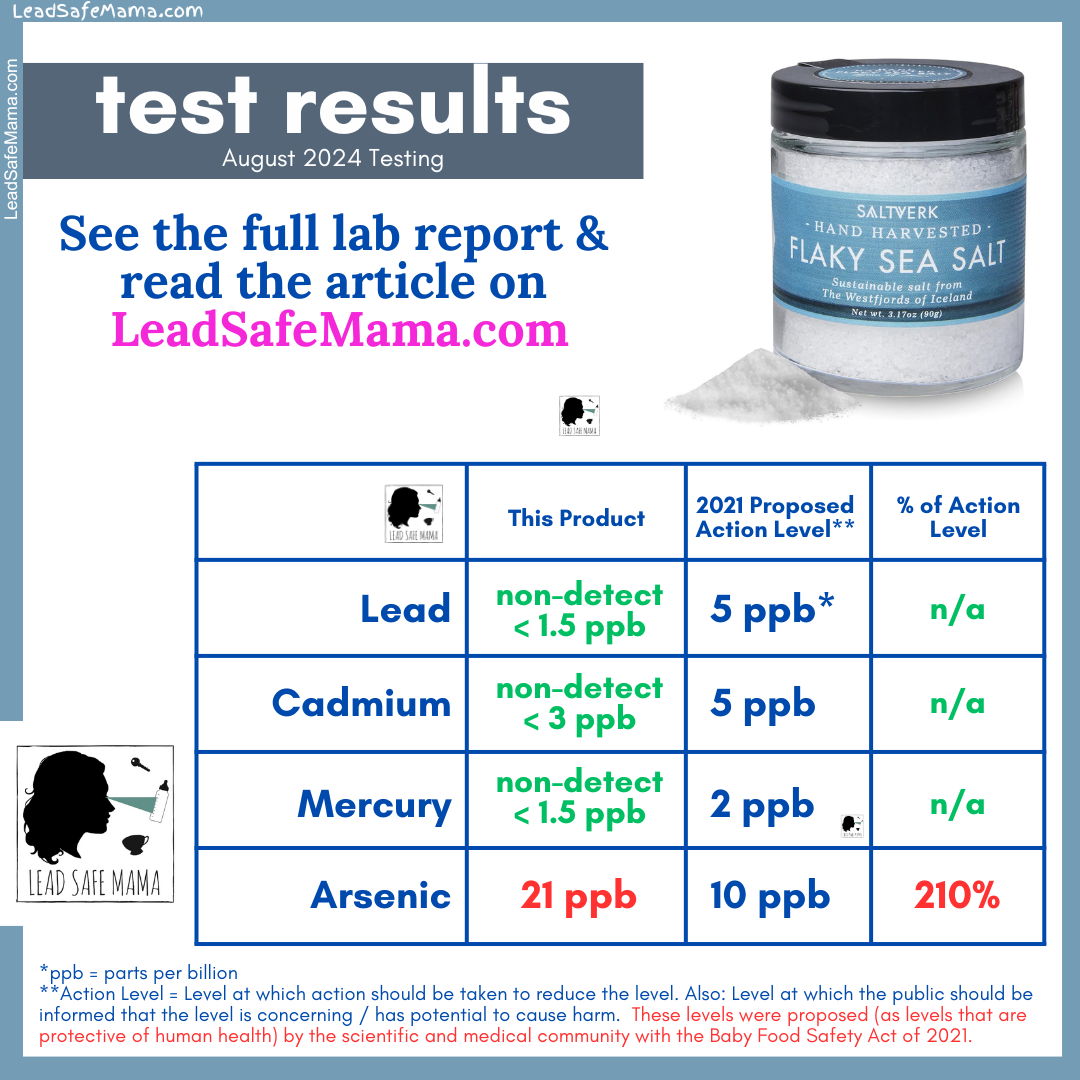
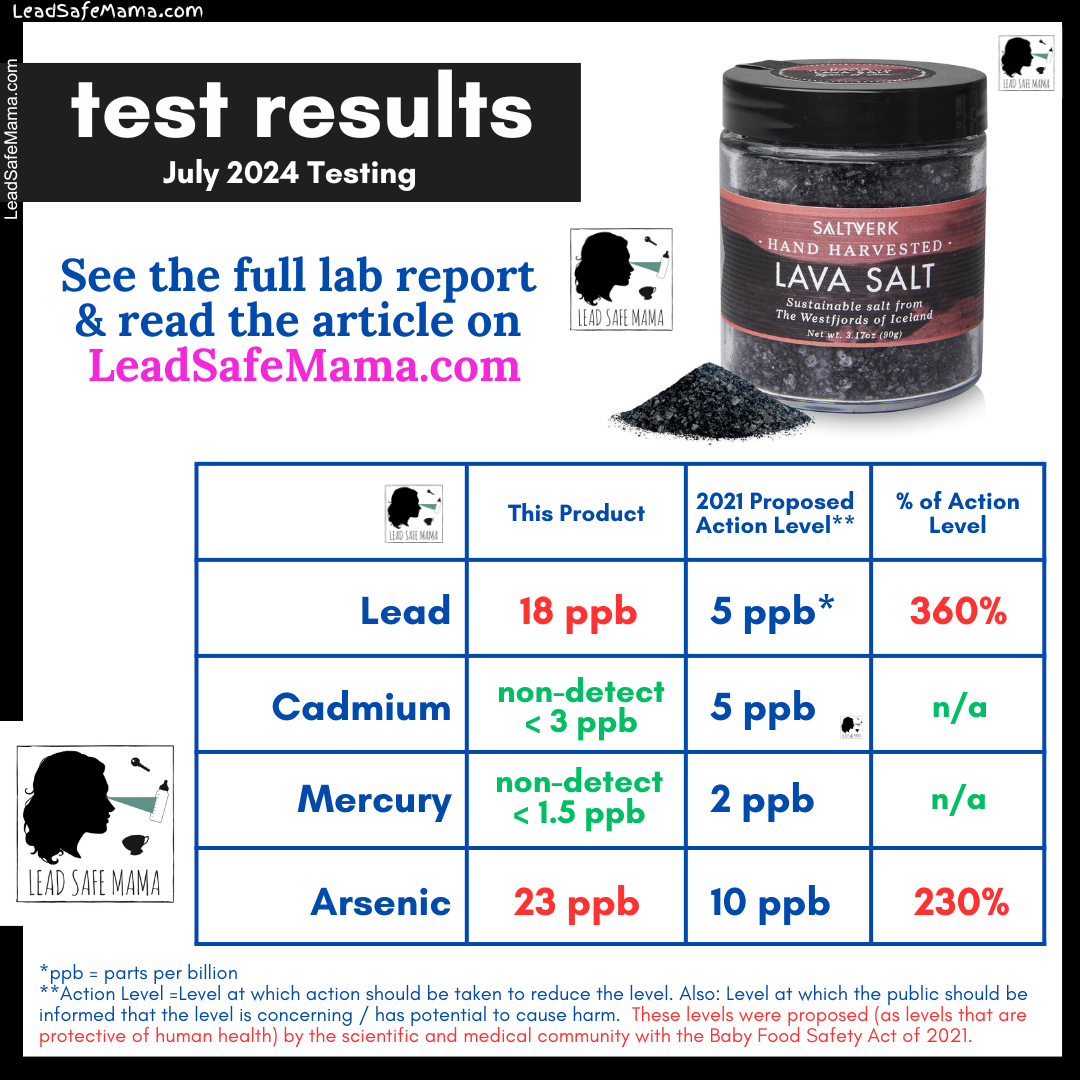
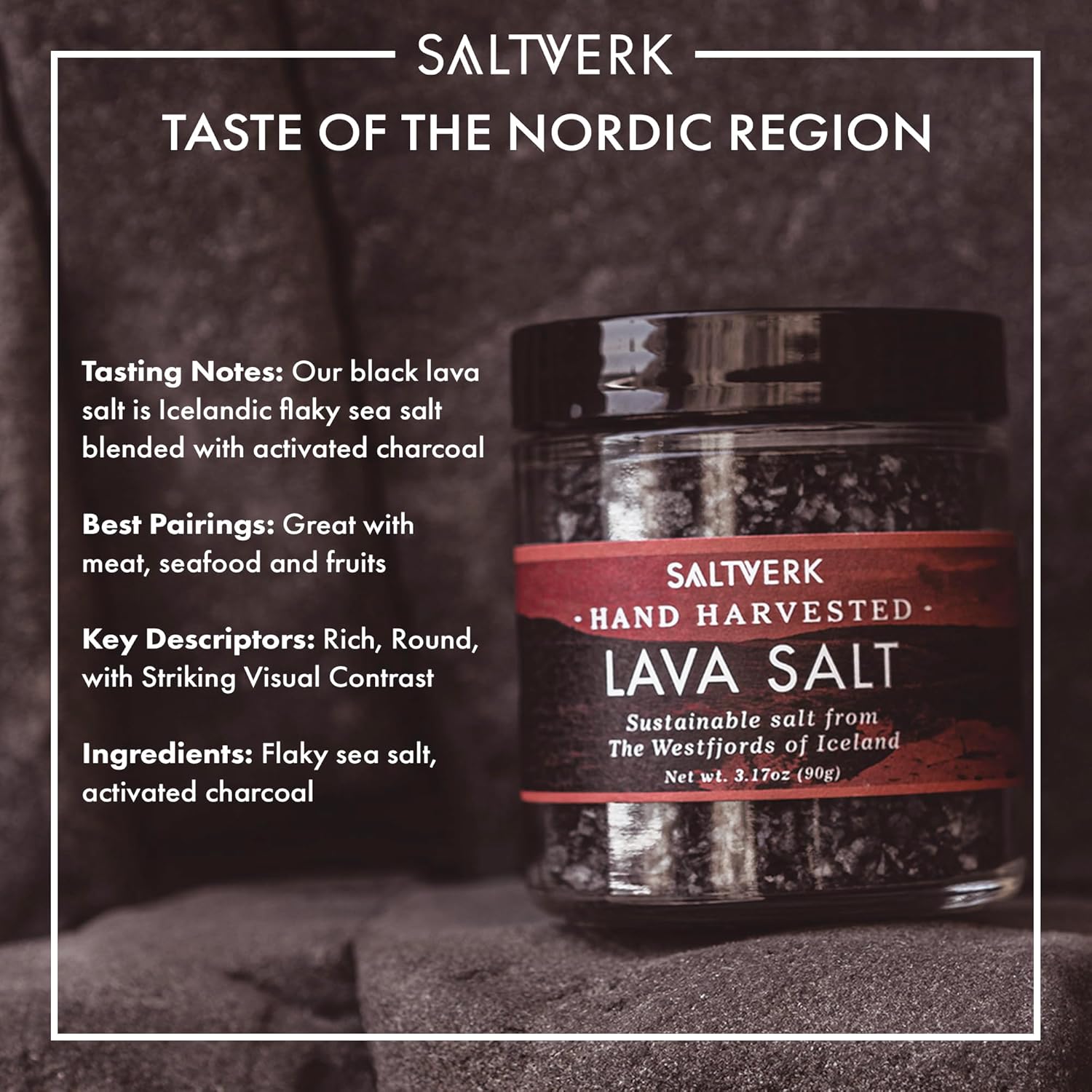
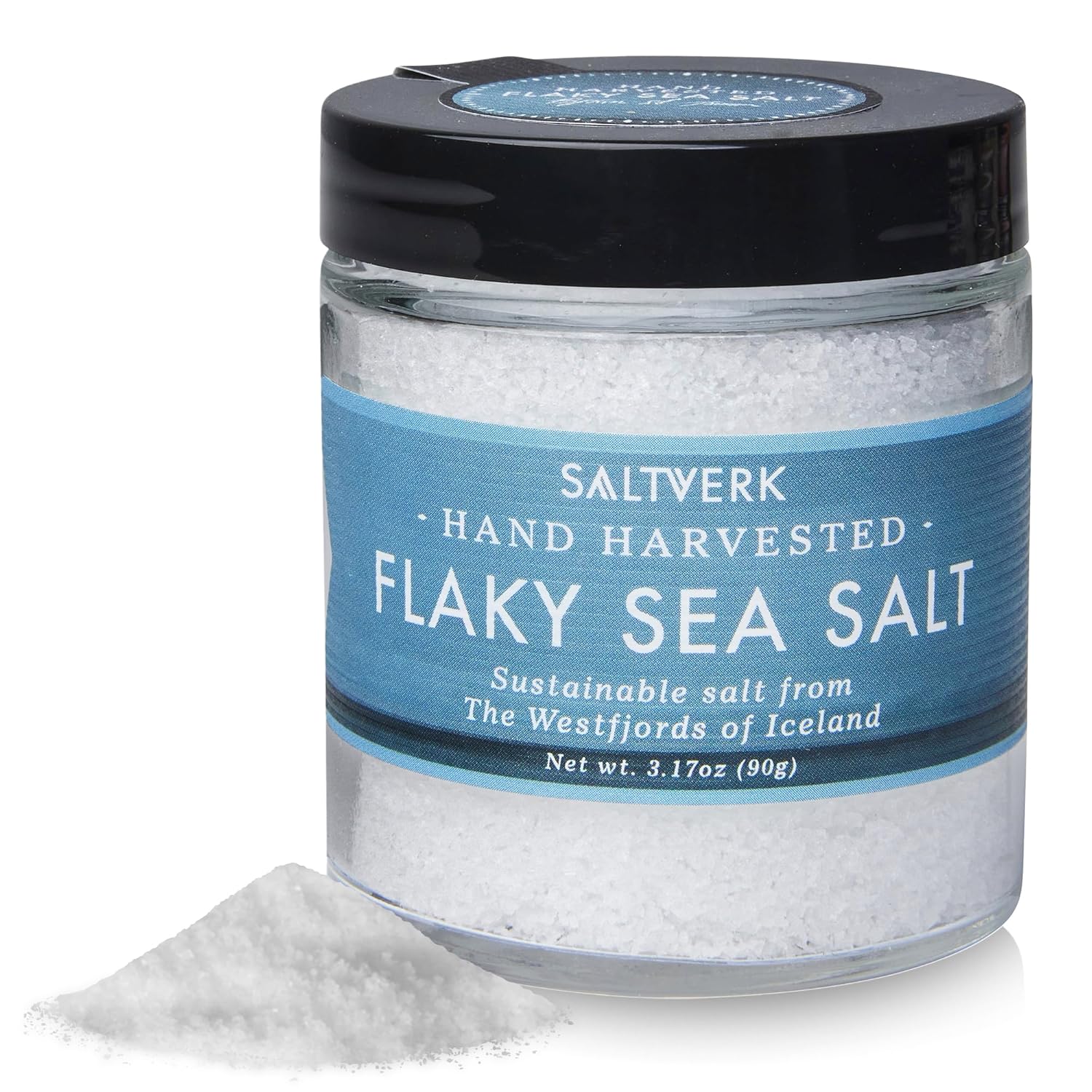
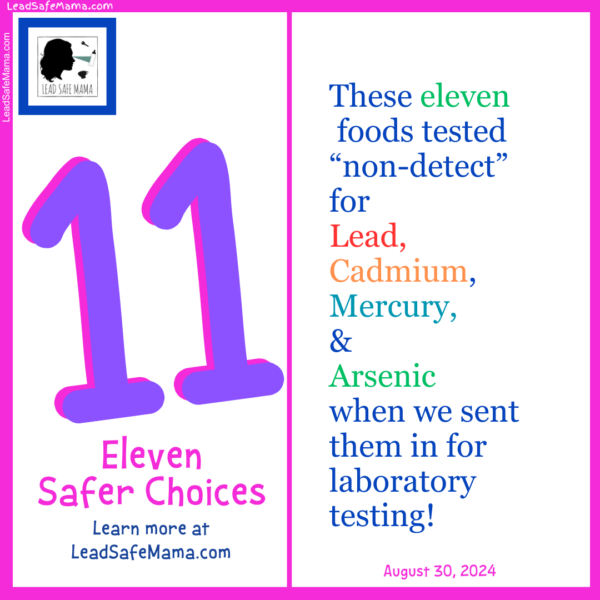
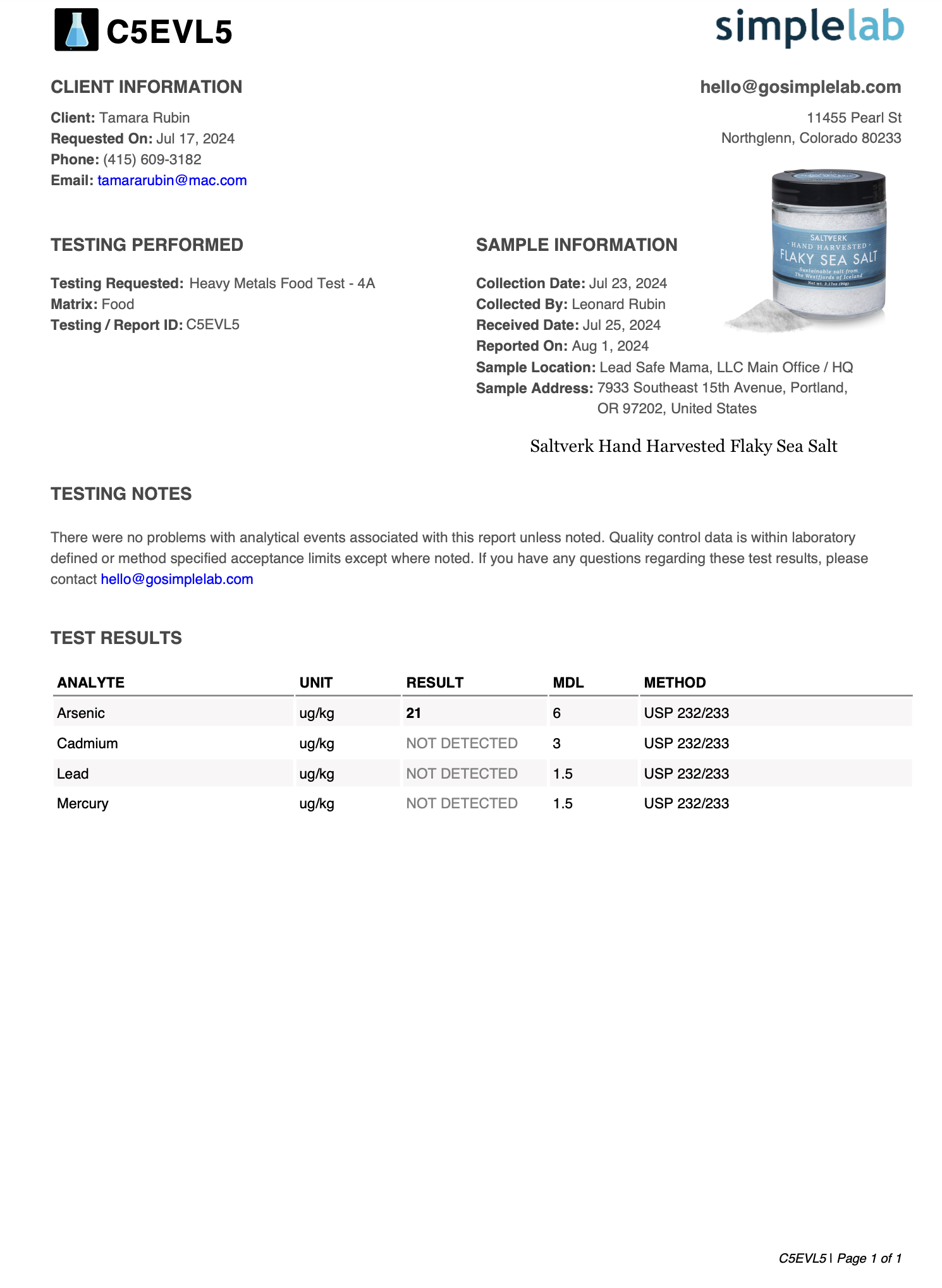

We have been using the white salt by this company because it was on your recommended list. Did it previously test clear and then this time with arsenic? Thanks for your help.
Previous studies (not by me) were only focused on Lead content. For Salt – this level of Lead is very low and in safe range in most applications. This salt would still fall in the “safer” salts category, but the Jacobsen’s is better / cleaner (just their Oregon sea salt, Their Italian salt tested positive for Lead).
I have purchased the Jacobson salt and must say, it tastes pretty good. I’ll be sticking with it from now on.
Me too! I just bought another package of it!
T
So we have switched to the Jacobson Oregon salt per your recommendations, but I’m just curious if it is recommended to test it frequently like once a year or if it will be considered safe forever?
test results have been consistent with what we previously reported, but we plan on retesting our “non-detect” items at least twice a year to confirm.
Thank you Tamara for your work. I bought this thinking No Lead to worry about.
I didn’t think about arsenic or other toxins!!
I almost let my daughter use it today and when I saw the Jacobsen salt near her, I had her use the SAFE SALT. BLESS YOU TAMARA!!
What about shampoo that has charcoal? Would this be of concern?
Activated charcoal is also used to filter water for drinking. Could it add lead to drinking water?
Very curious about this myself too!
Dang it I just bought this last month cause I saw it on this safe list.. too late to send back but atleast now I know. I’ll just go buy the Jacobson now
It’s still on the “safe” list for salts – it’s among the safest salts – but not as safe as Jacobsen’s. Our Salt list (which aggregated data from several sources) did show this as testing positive for 30 ppb Lead, so it is excellent that it was non-detect for Lead at least. Until this point we had no access to information about Arsenic – but this level of Arsenic is also considered “safe” – by all standards (standards relevant to salt, not baby food).
T
Have microplastics been detected in this salt or any other salt like Jacobsen’s?
Jacobsen filters for microplastics as I understand it – check out their website.
Nordur Salt Co. is a Icelandic salt that’s been popular in Europe, and has recently become available in the US. I wonder how it compares to the other Icelandic salts you’ve tested? It still seems like Icelandic salts are doing better than most others in terms of purity. I’d really like to know what your results would be!